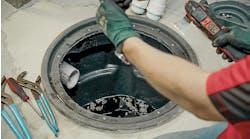Recently Dave Roush of Roush Plumbing & Heating in Marion, Ohio, finished replacing an aged prototype ground-source pump-and-dump geothermal heat pump with a brand new system in my parents’ home.
About 30 years ago, my dad Larry Kersey, an electrician with the Ohio Edison Company, took the company up on its offer to subsidize the installation of geothermal heating and cooling. Geothermal was a new idea, and my dad had trouble finding a contractor who even understood what geothermal was, let alone knew how to install it.
Geothermal is attractive
What brought this geothermal system to the forefront is that I had finally gotten an offer from someone to buy my parents’ house. It is in rural Marion, Ohio, where property sales are moving very slowly. The realtor cautioned me that a weird heating system could add to the difficulty of selling. People might not want something that complicated. I was prepared to have it replaced with a conventional forced air system.
Sure enough, the old geothermal system was a problem, but in a different way than what I expected. Not surprisingly, it did not pass inspection. I called Dave Roush, the expert who has been keeping it running all these years, and asked him if it really didn’t work, or if the inspector just didn’t understand it.
“Oh, it’s shot,” Roush said. “I can’t fix it any more because you threw away all the spare parts when you cleaned out the basement for that auction you had. They don’t make that stuff any more. There were belts for that old oil furnace that was still serving as the blower.”
Well, I’ll be … So that pile of junk on the corner shelf was spare parts. I should have known.
So following the realtor’s thought that a buyer would find a geothermal heat pump system too complicated, I proposed replacing it with a simple conventional forced air system. To my great surprise, the buyer responded back that she wanted geothermal. That was one of the things that attracted her to the house! On the one hand I was disappointed because installing a conventional system would have been much less expensive. But I was pleased to have a buyer who recognized and appreciated the virtues of geothermal.
Original system
The program that my dad took advantage of provided an employee rebate for the installation of a geothermal heat pump. Alas, there was no special rate for electricity, but it turns out that it didn’t take much electricity, mostly just enough to run the well pump, and to circulate the water. Part of the program was that the employee had to agree to gather data, which was right up my dad’s alley. Ohio Edison provided the meters and other recording devices, and every day for years my dad manually recorded data.
This system was installed in the early 1980s. Geothermal was so new, in fact, that the heat pump was a prototype, fabricated in a garage in nearby Delaware, Ohio. The owner developed the specifications on his own. Roush says he has run into a number of units over the years, and that each was unique, made of off-the-shelf parts available at the time of manufacture. Roush said, “The guy was really in the business. He knew what he was doing. I guess that was proven by this 30-year-old unit I just removed.”
Roush continued, “It helped of course that your folks kept up on the maintenance. They had us out there one to two times a year just to look it over. Any breakdowns were minimal. There were really very few of them over the years. The problem got to be that it was just real hard to get parts. It got so that I could use only generic replacement parts —whatever I could figure out to make it work.”
The original system was dual fuel. The backup was oil — the house’s original oil furnace. Roush said, “The oil pumps ran on belts. They were the first I had ever seen. But with the heat pump, the backup was seldom used. I don’t know how old that oil in the tank was when we took it out. The blower for the geothermal was the same as the oil furnace. Nothing is designed like that today! Most are electric backup now.”
A notable element of the employee program back then is that Ohio Edison did a heat loss calculation before the system was designed. Roush said, “They computed the fuel cost per month, and according to your dad, the actual cost turned out to be pretty close. And it wasn’t very much.”
And the original system had a water coil. It was a pump-and-dump system. Water was pulled from the ground with the same pump as for household water. “That’s the most efficient way to do it because the water is a constant temperature year round,” said Roush. “It’s more efficient than the loops we use today where the water is re-circulated. The pump-and-dump system drew water up from the ground, ran it through the water coil, and deposited it back into the ground. In the summertime, the water was run through a sprinkler system to water the lawn before it was released!”
Of course water conditions had to be ideal to do a pump-and-dump. In that part of the world they were back then, but things have changed. The old system required 12 gallons per minute (GPM) of water, and there was no problem getting that. Today available water is more like 6 GPM. In many parts of the same county, it’s only 3 GPM. To do this system today, most houses would require a separate well rather than one that also provides domestic water. And of course the water had to have no excessive minerals such as iron and sulphur.
Many locations that in those days would have been on wells are now on city water, appropriate to use only with a loop system. Fortunately, newer systems use much less water because they have a compressor. Because of the changes in the local water supply, Roush said he has replaced a number of pump-and-dump systems in the last few years.
A good future
Roush replaced my dad’s system with a new Bard Geotech heat pump made in nearby Bryan, Ohio. Roush said, “I like Bard because they’re local, and they got into the heat pump business in the early 1980s and stayed with it.”
Since the house hasn’t been significantly changed, he used the same heat loss calculation as for the original installation.
Roush sees a good future for geothermal heat pumps. “A few more are going into new housing because people want to build a more efficient house and keep utility costs down. In rural areas that means they can save about $100 a month and apply that to the house payment. And there are still some rebates out there from the smaller rural utilities.”
Carol Fey is a technical trainer who has been in the HVAC industry for over 25 years. You can find her books and DVD at www.carolfey.com. To see her adventures while a heating mechanic in Antarctica, go to www.carolfey.blogspot.com.

